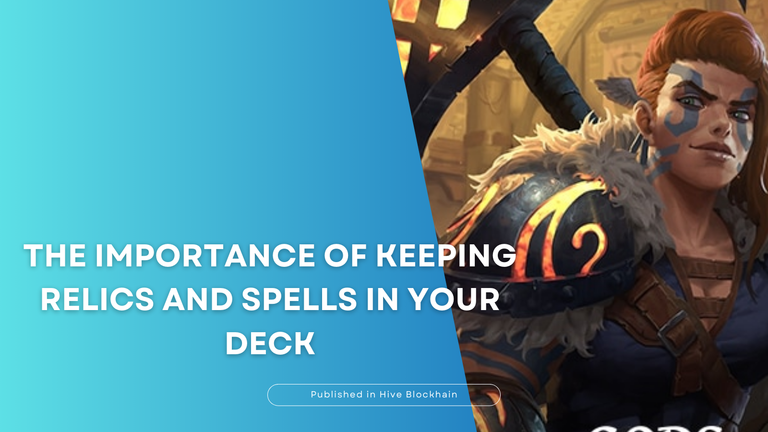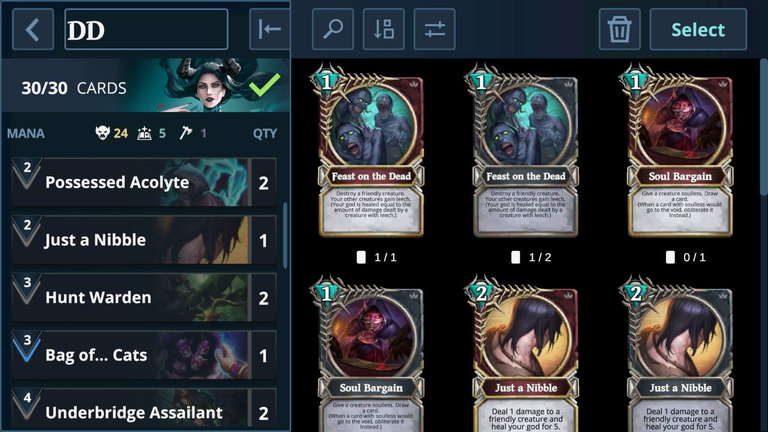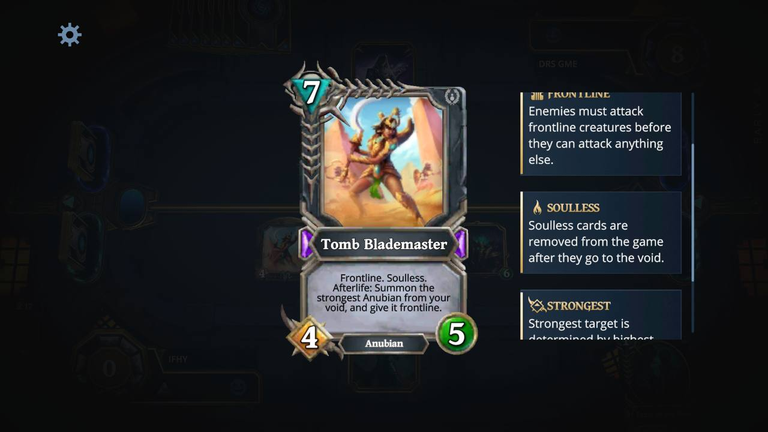| Latest Gods Unchained Post |
|---|
| Gods Unchained: Previous Weekend Ranked Package Rewards, Opening More Packs [EN/PT] |

Greetings.
Recently, I have been reflecting a lot on how I’ve been building my deck in the game. Since I started playing, I was very focused on creating compositions geared towards active creatures, something that seemed natural at first, considering the simplicity of understanding how these cards work and how they interact on the battlefield.
After all, the more creatures I can summon, the greater the pressure on my opponent, right?
Well, over time, I realized that this strategy has its limitations, and they are not few. In fact, relying solely on creatures can significantly limit the chances of victory.
In the beginning, my thought was simple:
By filling the battlefield with strong creatures, it would be easy to dominate the game in less time, however, the more I faced more experienced opponents, the more I began to realize how this could be a mistake, especially when playing with the Death Deck, which has become my favorite. Creatures with good attributes are interesting, but they depend a lot on the support they receive from Relics and Spells. Relics, for example, are useful for keeping pressure on the opponent over several turns without spending valuable resources, such as creatures, while Spells can turn the game around with unpredictable and devastating effects.
But I wasn’t focusing on this, and it set me back a bit.
As a player of a Death-focused deck, the cards I often use have effects that trigger when creatures die, or, in many cases, require the elimination of one or more creatures on my side of the field to unleash their true potential. The problem here is clear: without a good mix of Relics and Spells, I find myself cornered, often sacrificing creatures inefficiently or simply missing the right moment to use them.

A clear example of this is the Feast on the Dead card, one of my favorites to mention in this post. It allows me to remove an enemy creature from the board and heal my God by adding Leech to all other living creatures, thus healing through the strength of a sacrificed allied creature.
Often, I find myself needing to sacrifice a weak creature like Imps summoned from others to activate the effect of Feast on the Dead, which can cost little for a good benefit. Additionally, without the support of a Relic or another Spell, I end up with fewer creatures on the field, leaving myself vulnerable.
On the other hand, we have Relics, which can be used on our Gods. Decks that include Relics can generate a lot of value over time. Recently, I started experimenting with the Anubian Scrounger, an interesting Relic for the Death Deck, which allowed me to maintain pressure without spending creatures.
Although it still costs a certain amount of mana, and I must be mindful of that, sometimes using this Relic makes no sense.
Another important detail is the unpredictability you can gain over your opponent.
A deck composed exclusively of creatures becomes easier to read and predict, of course, for experienced players it’s easy to guess what your next step will be based on your recent battles. The opponent can easily calculate your next moves and prepare adequate responses. On the other hand, when I diversify my cards with Relics and Spells, I increase the number of possible interactions in the game, creating a level of unpredictability that gives me a tactical advantage.
One example of a mistake I’ve made constantly is using high-value cards, like Tomb Blademaster, which I often couldn’t even use, yet it occupied an important space in my deck.

Decks built solely with creatures limit my options and make my strategy predictable and vulnerable. A good deck needs a balance between creatures, Spells, and Relics. Playing with the Death Deck, this need becomes even more apparent, as the mechanics of sacrifice and creature removal are crucial to extracting maximum value from the cards.


About the Author
@ifhy is an enthusiast who dedicates some of his time to #Play2Earn games and the Web3 ecosystem. A weekly author on Hive.blog through posts about games involving the Hive ecosystem and other blockchains.
Among the variety of his content between digital games, whether or not they are powered by blockchains, you can mainly check out posts related to #Splinterlands, #GodsUnchained, #dCity, and many other games.
📝 Versão em Português
| Latest Gods Unchained Post |
|---|
| Gods Unchained: Previous Weekend Ranked Package Rewards, Opening More Packs [EN/PT] |

Saudações.
Recentemente, tenho refletido bastante sobre a maneira como venho montando meu deck no jogo. Desde que comecei a jogar, estava muito focado em criar composições voltadas para criaturas ativas, algo que me parecia natural no início, considerando a simplicidade de entender como funcionam essas cartas e como elas interagem no campo de batalha.
Afinal, quanto mais criaturas eu puder invocar, maior será a pressão sobre meu oponente, certo?
Bom, com o tempo, percebi que essa estratégia tem suas limitações, e não são poucas. Na verdade, confiar apenas em criaturas pode limitar significativamente as chances de vitória.
No começo, o meu pensamento era simples:
Enchendo a batalha de criaturas fortes, seria fácil dominar o jogo em menor tempo, contudo, quanto mais eu enfrentava oponentes mais experientes, mais comecei a perceber como isso podia ser um erro, especialmente jogando com o Deck de Morte que tem se tornado meu favorito. Criaturas com bons atributos são interessantes, mas dependem muito do suporte que recebem de Relics e Spells. Relics, por exemplo, são úteis para manter pressão no oponente ao longo de vários turnos sem gastar recursos valiosos, como criaturas, enquanto os Spells podem virar o jogo com efeitos imprevisíveis e devastadores.
Mas eu não estava focado nisso, isso me deixou um pouco para trás.
Como jogador de um deck focado na Morte, as cartas que eu uso frequentemente possuem efeitos que se ativam quando as criaturas morrem, ou, em muitos casos, exigem a eliminação de uma ou mais criaturas no meu lado do campo para liberar seu verdadeiro potencial. O problema aqui é evidente, sem uma boa mistura de Relics e Spells, eu me vejo encurralado, muitas vezes sacrificando criaturas de maneira ineficiente ou simplesmente perdendo o momento certo de utilizá-las.

Um exemplo claro disso é a carta Feast on the Dead, uma das minhas preferidas para ser mencionada nessa postagem. Ela permite remover uma criatura inimiga do tabuleiro e curar o meu Deus adicionando Leech para todas as outras criaturas vivas, curando assim na força de uma criatura aliada sacrificada.
Muitas vezes me vejo na necessidade de sacrificar uma criatura fraca como Imps invocados de outros para para ativar o efeito de Feast on the Dead, o que pode custar pouco a um bom beneficio. Além disso, sem o apoio de uma Relic ou de outro Spell, acabo ficando com menos criaturas no campo, tornando-me vulnerável.
Do outro lado então temos Relics, que podem ser utilizadas em nossos Deuses, decks que incluem Relics podem gerar muito valor ao longo do tempo. Recentemente, comecei a experimentar a Anubian Scrounger, uma Relic interessante para o Deck de Morte, que me permitiu manter a pressão sem gastar criaturas.
Embora ainda se gaste uma quantidade de mana, então tenho que ficar atenciosos a isso, algumas vezes utilizar essa Relic não tem o menor sentido.
Outro detalhe importante é a imprevisibilidade que você pode obter sobre seu adversário.
Um deck composto exclusivamente por criaturas se torna mais fácil de ler e de prever, é claro, para experientes é facil adivinhar qual será seu próximo passo baseado nas suas ultimas batalhas. O oponente consegue calcular facilmente os próximos movimentos e preparar respostas adequadas. Por outro lado, quando diversifico minhas cartas com Relics e Spells, aumento a quantidade de interações possíveis no jogo, criando um nível de imprevisibilidade que me dá vantagem tática.
Um exemplo de erro que eu tenho feito constantemente, é utilizar cartas de valores altos, como Tomb Blademaster, muitas vezes eu mal conseguia chegar a utilizar ele, mas ocupava um espaço importante no meu Deck.

Decks construídos apenas com criaturas limitam muito as minhas opções e deixam minha estratégia previsível e vulnerável. Um bom deck precisa de equilíbrio entre criaturas, Spells e Relics. Jogando com o Deck de Morte, essa necessidade se torna ainda mais aparente, pois as mecânicas de sacrifício e remoção de criaturas são fundamentais para extrair o máximo de valor das cartas.


Sobre o Autor
@ifhy é um entusiasta e dedica um pouco do seu tempo a jogos #Play2Earn e pelo ecossistema Web3. Autor semanal em Hive.blog através de postagens sobre jogos envolvendo o ecossistema Hive e outras blockchains.
Dentre a variedade entre seus conteúdos entre jogos digitais sendo ou não sendo alimentados por blockchains, você pode conferir principalmente postagens referentes a #Splinterlands, #GodsUnchained, #dCity e outros diversos jogos.

